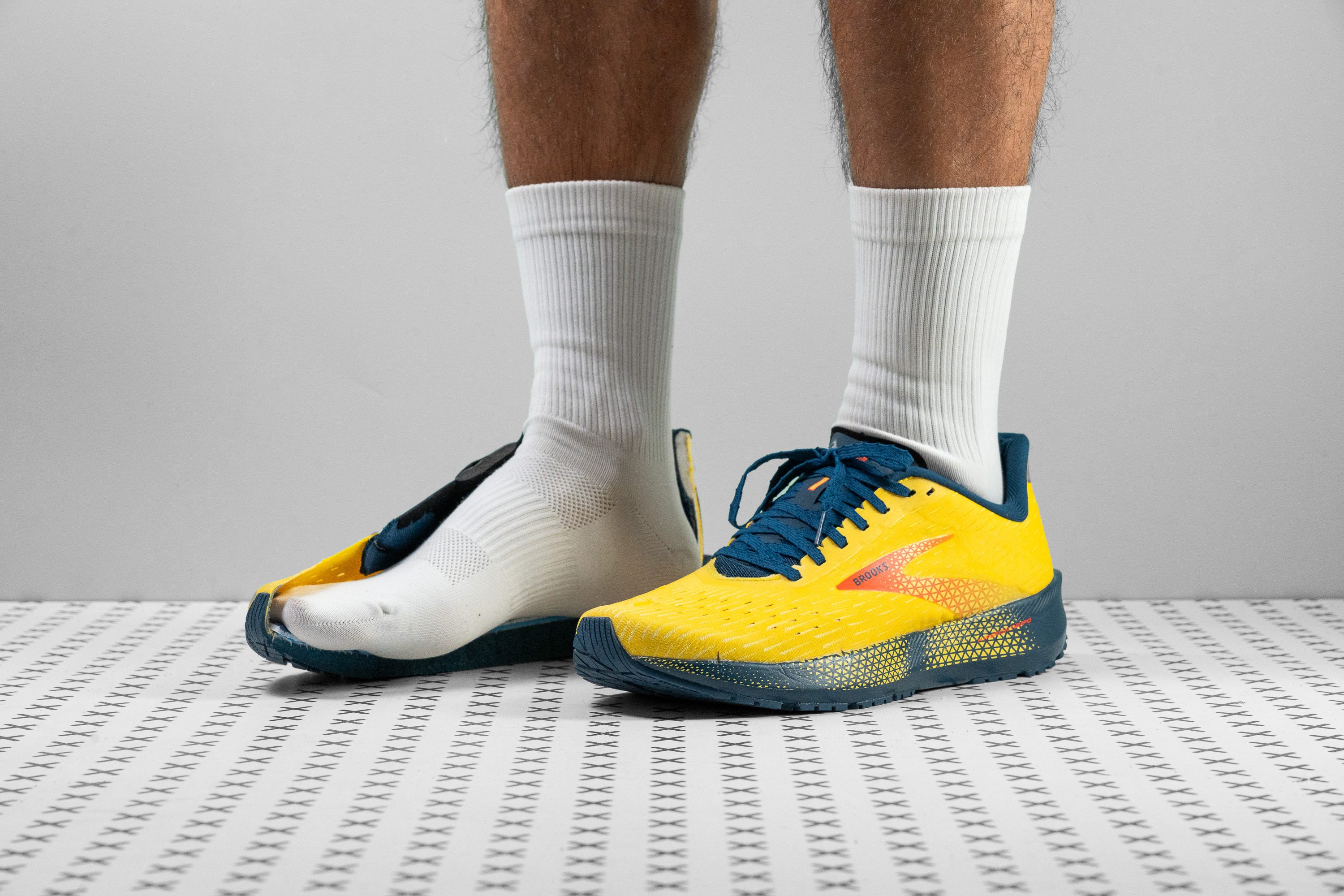Our verdict
Pros
- Exceptionally lightweight
- Ideal for track workouts
- Upper fits comfortably
- Durable outsole and upper
- Good breathability
- Feels quick and agile
- Great for developing foot muscles
- Great for developing foot muscles
Cons
- Heel could benefit from more energy return
- Not suitable for long runs at all
- Might be slightly overpriced
- Slippery when wet
Audience verdict
- Top 28% in road running shoes
- Top 25% in Brooks running shoes
Comparison
The most similar running shoes compared
+ + Add a shoe | |||||
|---|---|---|---|---|---|
| Audience score | 89 Great! | 90 Superb! | 89 Great! | 90 Superb! | |
| Price | £150 | £110 | £170 | £165 | |
| Pace | Tempo | Daily runningTempo | CompetitionTempo | Daily runningTempo | |
| Shock absorption | Moderate | High | High | Moderate | |
| Energy return | Low | Moderate | High | Moderate | |
| Traction | Moderate | High | High | Moderate | |
| Arch support | Neutral | Neutral | Neutral | Neutral | |
| Weight lab Weight brand | 7 oz / 198g 7 oz / 199g | 8.6 oz / 245g 8.4 oz / 238g | 7.1 oz / 200g 6.9 oz / 196g | 8.6 oz / 244g 8.6 oz / 244g | |
| Lightweight | ✓ | ✓ | ✓ | ✓ | |
| Drop lab Drop brand | 9.0 mm 8.0 mm | 8.2 mm 9.0 mm | 7.8 mm 6.0 mm | 9.4 mm 10.0 mm | |
| Strike pattern | HeelMid/forefoot | HeelMid/forefoot | Mid/forefoot | HeelMid/forefoot | |
| Size | True to size | Half size small | Half size small | True to size | |
| Midsole softness | Balanced | Balanced | Soft | Soft | |
| Difference in midsole softness in cold | Small | Small | Small | Normal | |
| Toebox durability | Good | Bad | Bad | Decent | |
| Heel padding durability | Decent | Good | Good | Good | |
| Outsole durability | Good | Decent | Bad | Decent | |
| Breathability | Moderate | Breathable | Breathable | Moderate | |
| Width / fit | Medium | Wide | Narrow | Medium | |
| Toebox width | Medium | Medium | Medium | Medium | |
| Stiffness | Flexible | Moderate | Moderate | Moderate | |
| Torsional rigidity | Flexible | Moderate | Stiff | Moderate | |
| Heel counter stiffness | Moderate | Flexible | Flexible | Stiff | |
| Heel lab Heel brand | 28.7 mm 28.0 mm | 34.9 mm 35.0 mm | 30.6 mm 33.0 mm | 33.0 mm 34.0 mm | |
| Forefoot lab Forefoot brand | 19.7 mm 20.0 mm | 26.7 mm 26.0 mm | 22.8 mm 27.0 mm | 23.6 mm 24.0 mm | |
| Widths available | Normal | NormalWide | Normal | NarrowNormal | |
| Orthotic friendly | ✓ | ✓ | ✓ | ✓ | |
| Season | All seasons | SummerAll seasons | SummerAll seasons | All seasons | |
| Removable insole | ✓ | ✓ | ✓ | ✓ | |
| Ranking | #97 Top 26% | #46 Top 13% | #90 Top 24% | #43 Top 12% | |
| Popularity | #176 Top 47% | #155 Top 42% | #284 Bottom 24% | #42 Top 12% |
Who should buy
We think the Brooks Hyperion Tempo is an exceptional choice for:
- Fans of racing flats from the past decade seeking a fun and long-lasting training shoe suitable for a variety of paces.
- Individuals looking for an ultra-lightweight shoe for track workouts who prefer not to use spikes.
- Runners aiming to strengthen their foot muscles with a non-plated, low-stacked shoe.
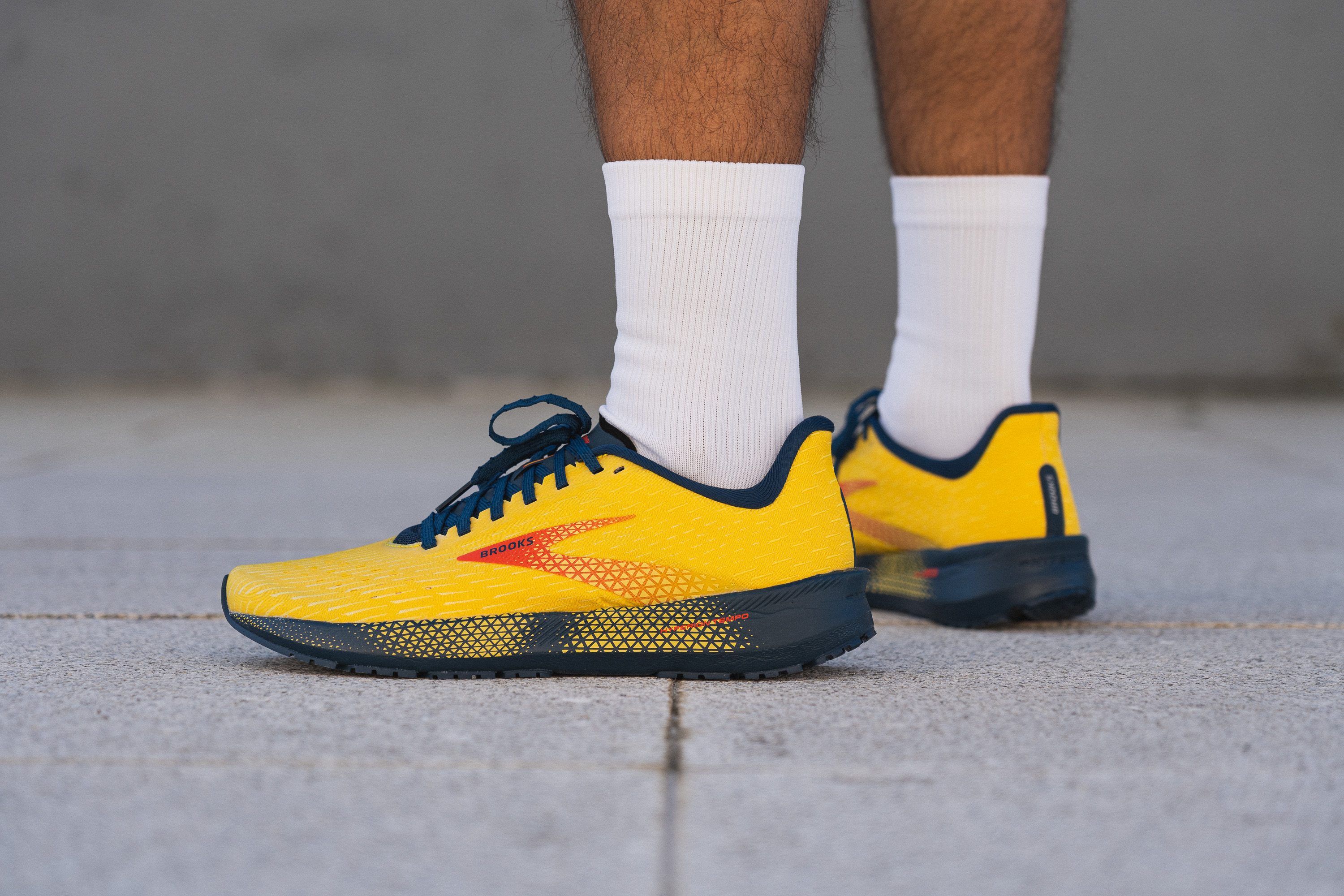
Who should NOT buy
We suggest passing on the Brooks Hyperion Tempo if you're searching for a non-plated shoe that can handle long runs. In our view, it lacks the necessary cushioning for runs exceeding an hour. For this purpose, we believe there are better yet still lightweight options on the market, such as the Brooks Hyperion Max or the Hoka Mach 5.
Also, if you're a fan of plush midsoles, the Brooks Hyperion Tempo might not be your ideal tempo shoe. A great alternative at a similar price point is the Nike Streakfly or the New Balance Rebel v3. Or, if adding a nylon plate to the mix doesn't bother you, we recommend the Saucony Endorphin Speed 3.

Cushioning
Shock absorption
The Hyperion Tempo delivers a unique ride. It has plenty of cushioning in the heel but intense ground feel up front.
Just check our numbers: 126 SA in the heel is about average, but 72 SA in the forefoot is strikingly low, making the ride super lively and fun, though definitely not for everyone.
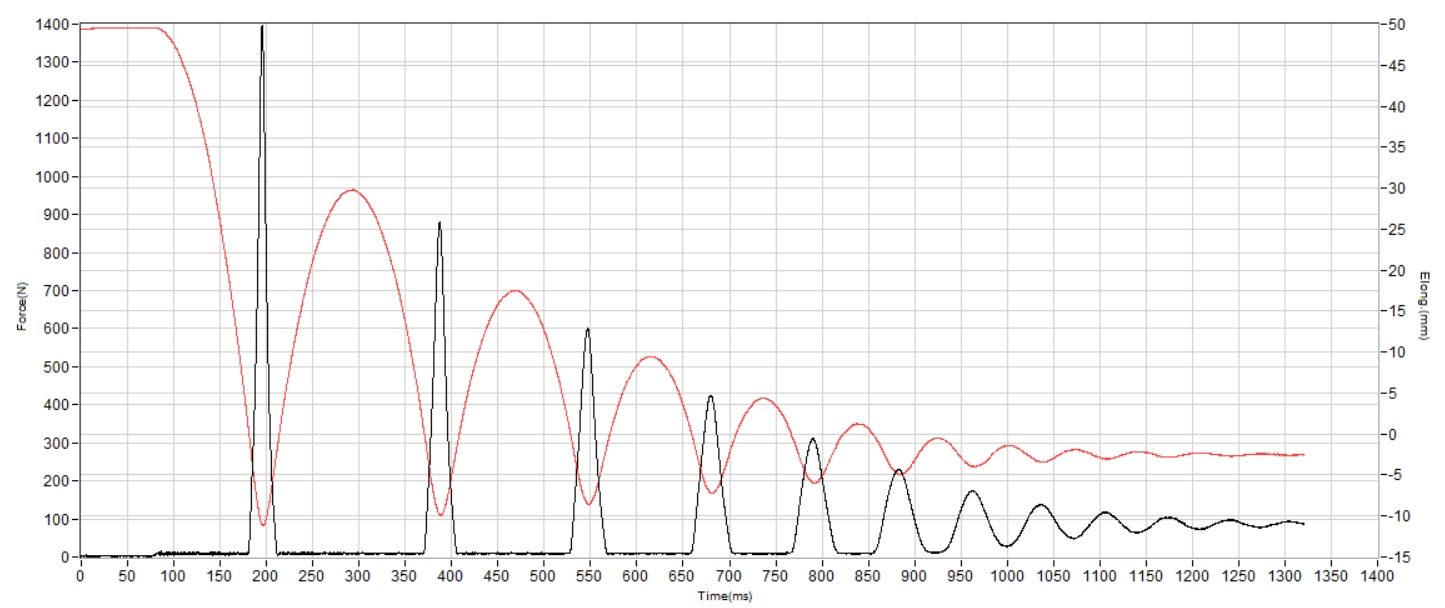
| Hyperion Tempo | 126 SA |
| Average | 129 SA |
Energy return
The forefoot proved to be ultra-reactive with 65.1%, while the heel lagged behind at just 52.6%. This clearly shows that the Hyperion Tempo is best suited for fast runners who land on the midfoot or forefoot.
| Hyperion Tempo | 52.6% |
| Average | 58.5% |
Heel stack
The heel stack of this shoe is slightly thinner than average, measuring only 28.7 mm.
This might be an issue for heavier runners who are heel strikers, as well as for those who want to use this shoe for long runs, since it's not designed for that purpose. However, for shorter, faster runs, it's a delight to run in.

| Hyperion Tempo | 28.7 mm |
| Average | 34.8 mm |
Forefoot stack
With just 19.7 mm in the forefoot, the Brooks Hyperion Tempo looks back to the past, aiming for those racing-flat vibes that engage your foot muscles and your ankle dorsiflexion.
This approach isn't bad at all—it's simply different. In an era dominated by carbon plates, it's beneficial to train and strengthen the muscles in your feet and enhance big toe mobility. The Brooks Hyperion Tempo is one of the best shoes on the market for this purpose.
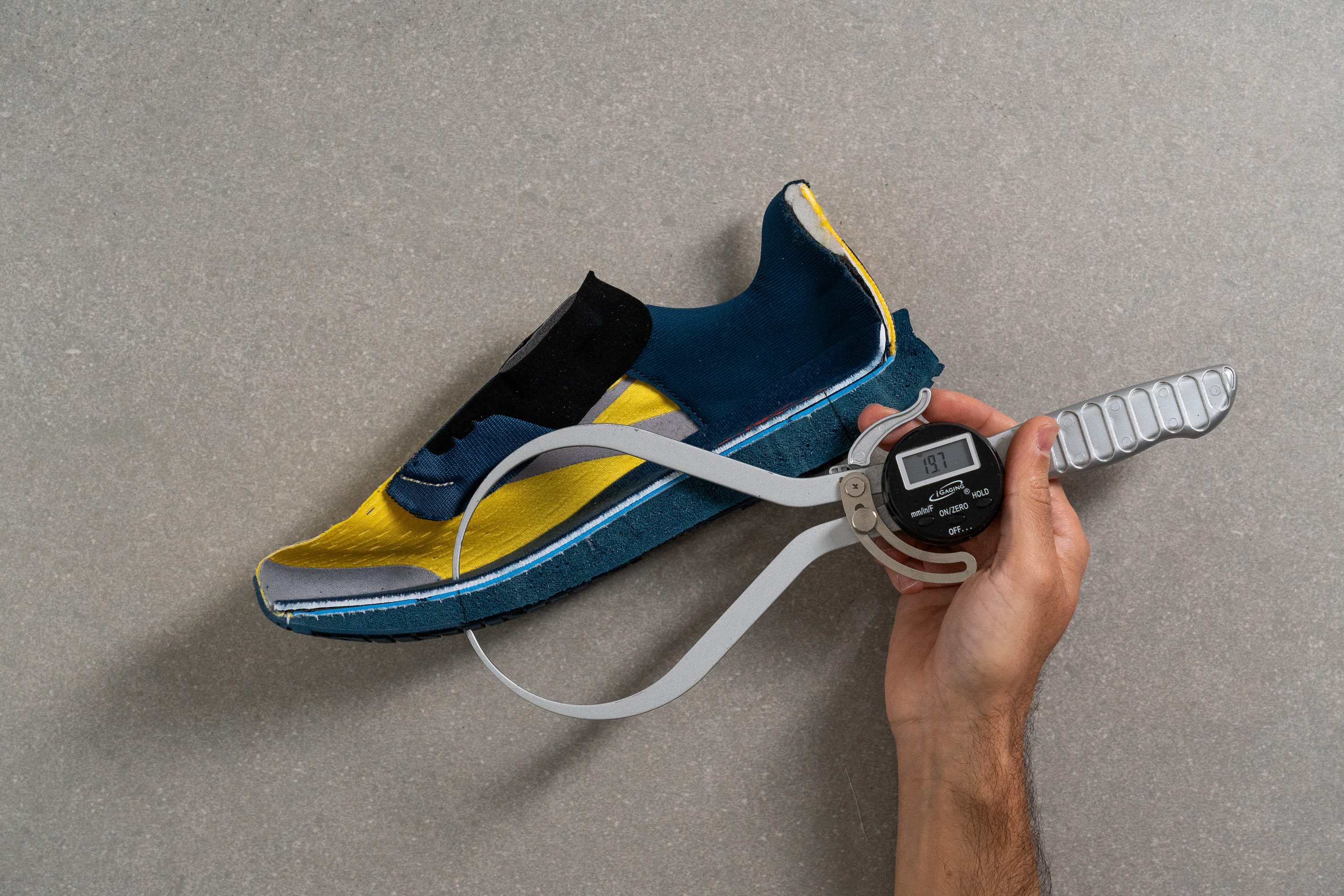
| Hyperion Tempo | 19.7 mm |
| Average | 26.2 mm |
Drop
The heel and forefoot difference results in a 9.0-mm heel-to-toe drop. This makes the Tempo a better option for heel strikers.
However, midfoot/forefoot strikers who plan to use this shoe for track workouts can also appreciate the reduced calf strain due to the high drop.
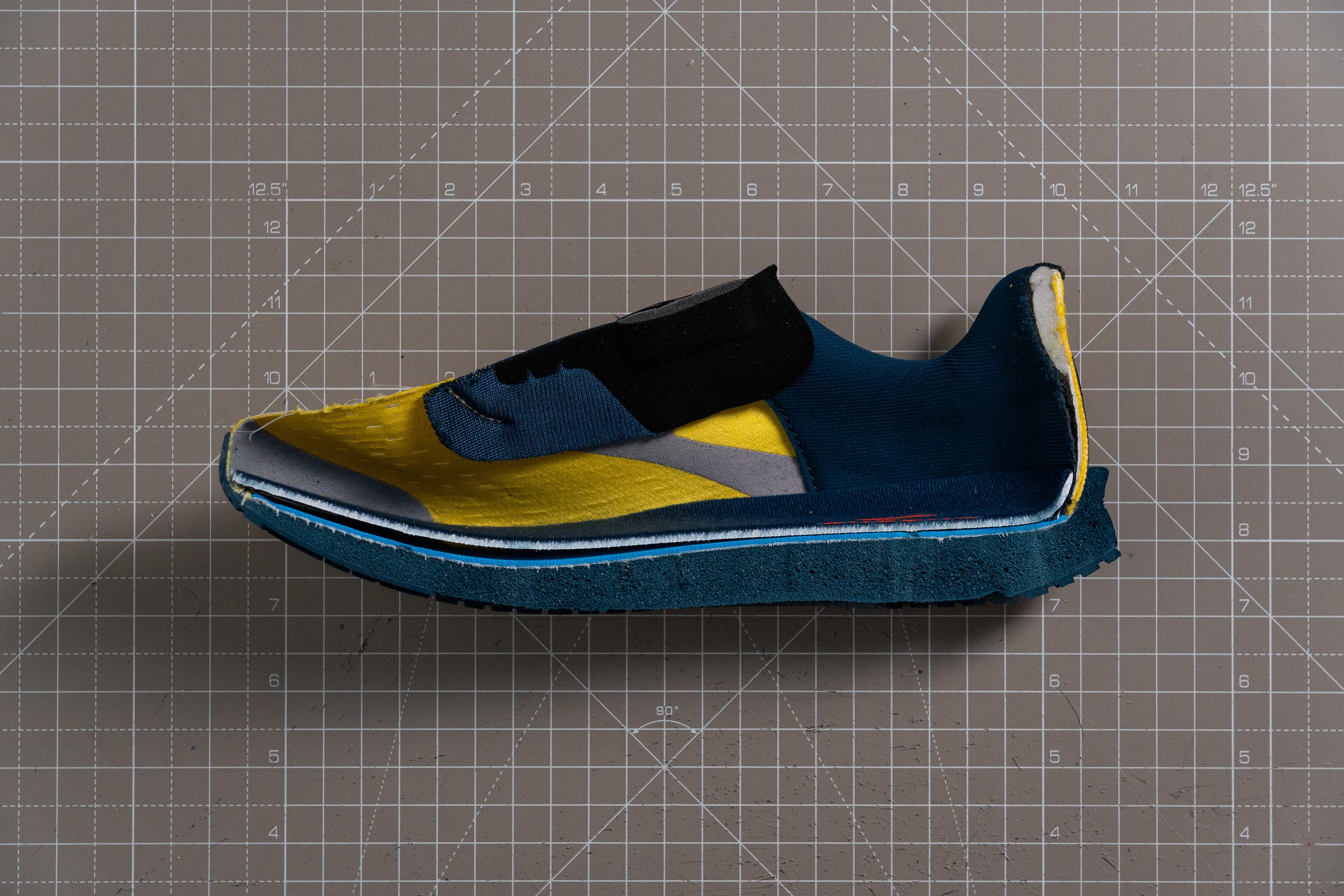
| Hyperion Tempo | 9.0 mm |
| Average | 8.6 mm |
Midsole softness
Our durometer measured the DNA Flash foam from Brooks at 22.3 HA, confirming our impressions from our test runs—while it's not firm, it tends more towards firmness than softness.
With such a thin midsole, it's crucial to avoid a super-soft formulation, as it would bottom out even for the lightest runners.
Opting for a balanced approach is smarter, though at fast paces, you'll definitely feel the ground—and that's okay.
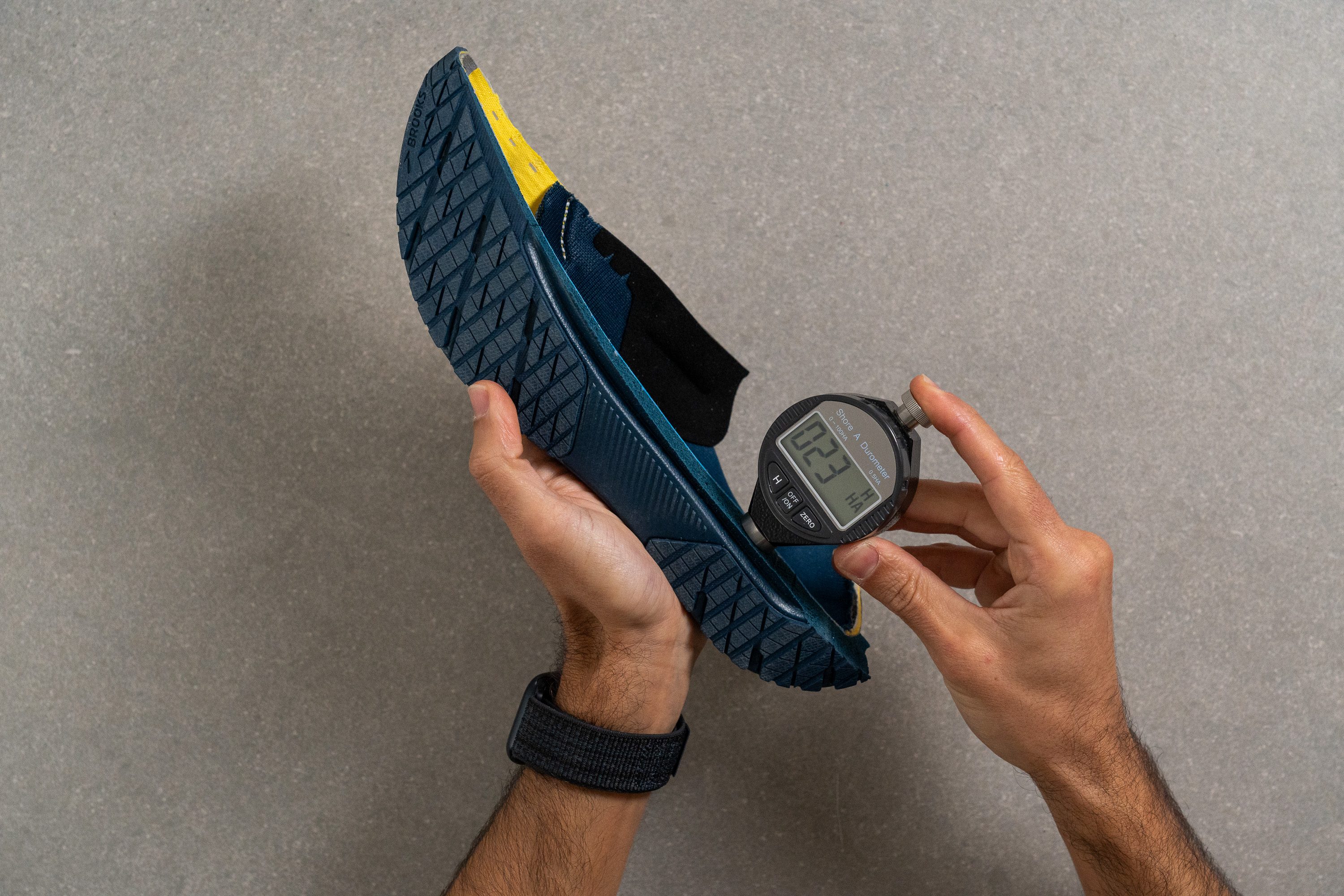
| Hyperion Tempo | 22.3 HA |
| Average | 20.4 HA |
Size and fit
Size
Brooks Hyperion Tempo fits true to size (132 votes).
Width / Fit
When we first handled this featherlight shoe, we worried it might feel too narrow. That concern disappeared as soon as we tried it on.
After analysing our precise gel mould of the shoe's interiors in the lab, our measurements confirmed those impressions. At 94.5 mm, it offers an average fit that accommodates most runners comfortably.

| Hyperion Tempo | 94.5 mm |
| Average | 95.1 mm |
Toebox width
Additionally, some runners with wide feet may also find comfort in this shoe, as it doesn’t taper much and is wider than the average shoe in the big toe area. This second measurement came in at a broad 75.9 mm!
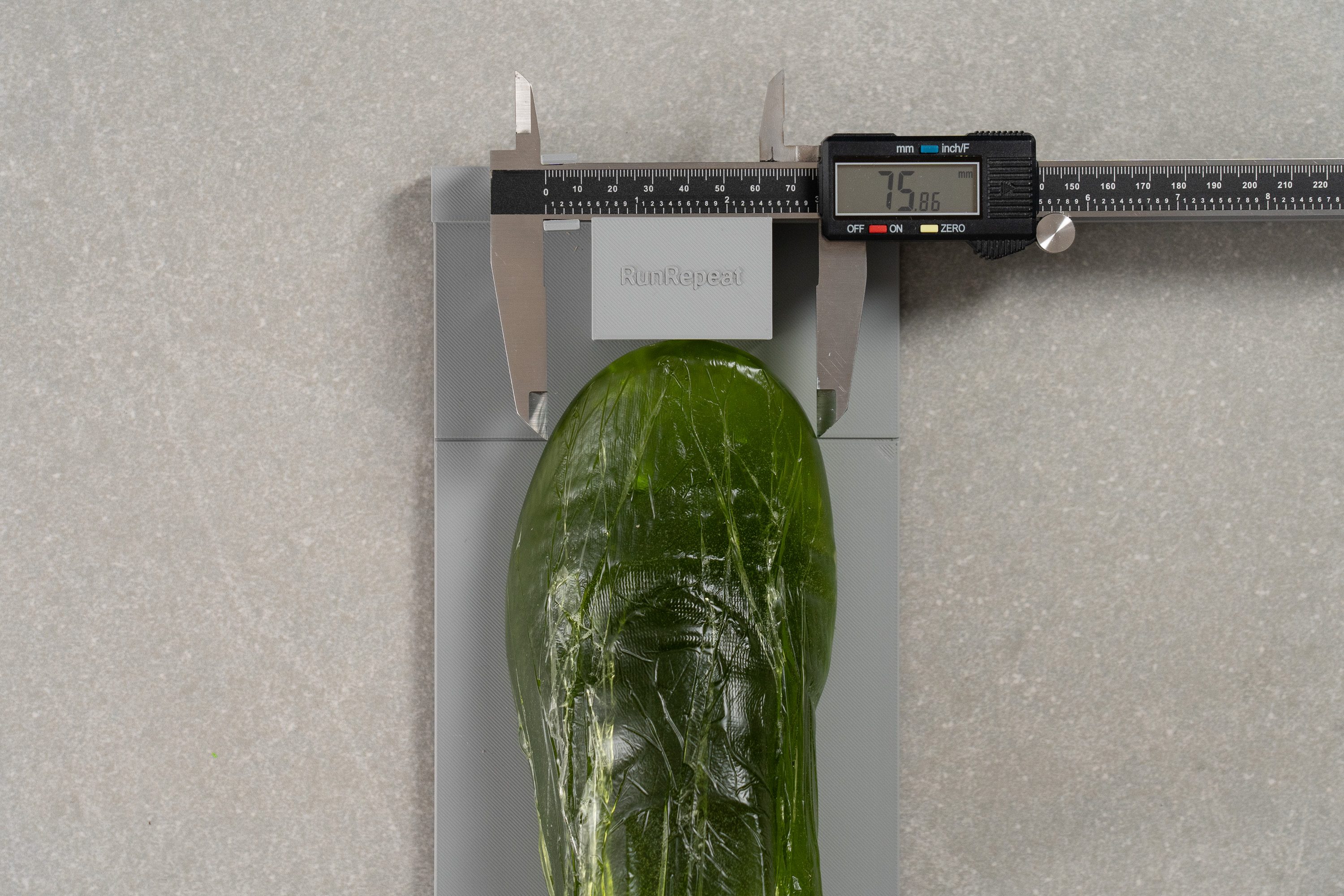
| Hyperion Tempo | 75.9 mm |
| Average | 73.2 mm |
Toebox height
This design from Brooks simply breaks from convention. While we were impressed by the broad horizontal space for the toes, the vertical volume disappointed us—measuring just 25.5 mm. Runners prone to toe pressure might want to avoid the Tempo.

| Hyperion Tempo | 25.5 mm |
| Average | 27.1 mm |
Traction / Grip
Traction test
We would think twice before taking the Brooks Hyperion Tempo out on wet pavement. Especially given that this is a speed oriented shoe and you will be pushing off the ground with added force.
Applying 500N of force to the shoe's forefoot at a 7-degree angle, we recorded a pretty low result in this brooks shoe. At only 0.29, it is notably lower compared to the results of other road running shoes and is not very confidence inspiring on slick concrete.
| Hyperion Tempo | 0.29 |
| Average | 0.48 |
Outsole design
We discovered strong rubber coverage in both the forefoot and heel, but the midfoot is completely exposed. So if you're someone who tends to wear down that area—a rare case—this setup may not be the best fit for you.
The outsole also includes a central channel designed to help with side-to-side flexibility and water drainage.
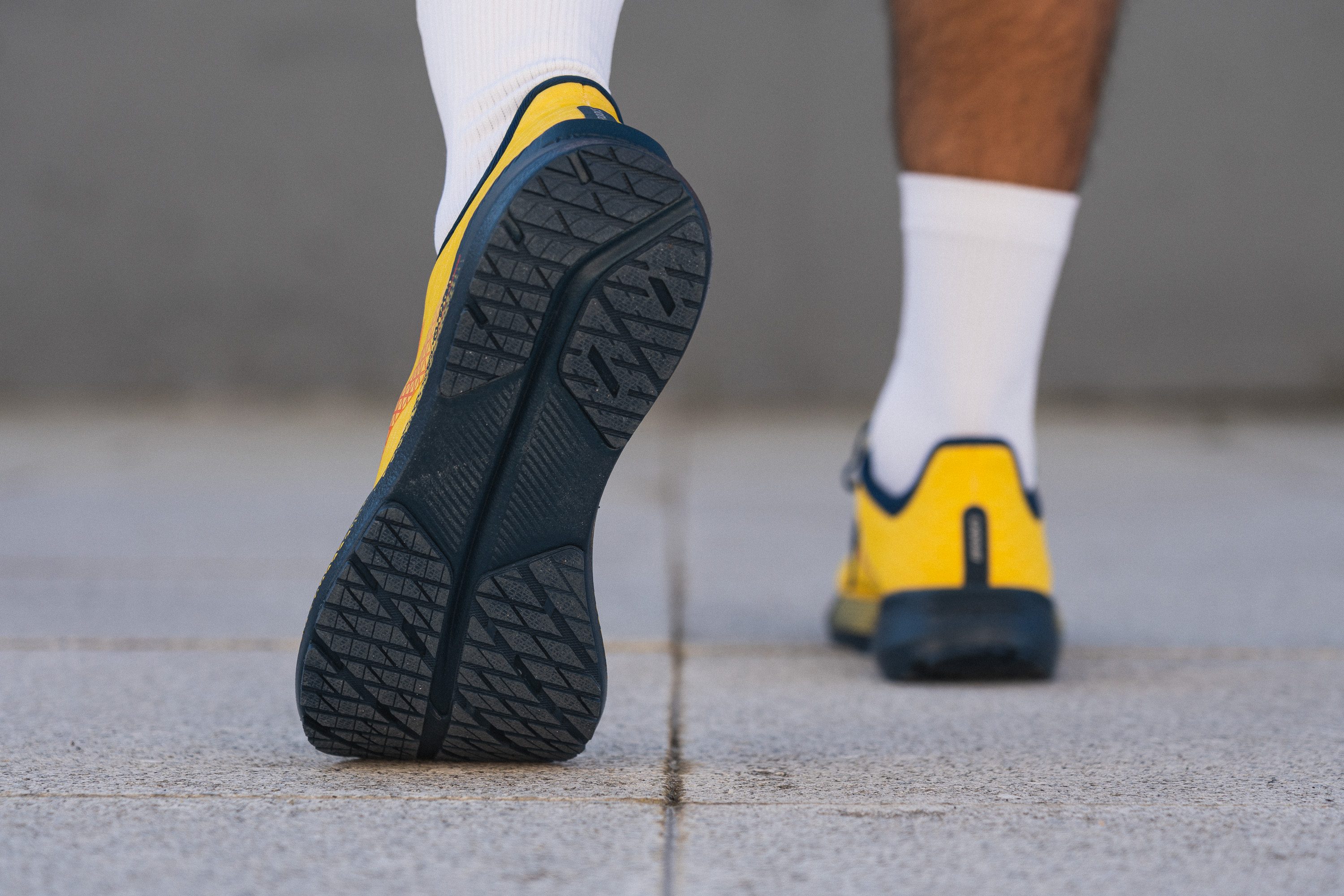
Flexibility / Stiffness
We already demonstrated how twistable this shoe is, and now it's time to test its longitudinal stiffness.
In our bend test, the Tempo scored similarly to a minimalist shoe, requiring only 7.7N of force. This is absolutely astonishing and again contributes to its comfortable ride. It also means the shoe can handle short, easy runs if needed. And you can bring it to the gym!

| Hyperion Tempo | 7.7N |
| Average | 15.3N |
Stiffness in cold
We repeated the same test under cold temperatures to see if the stiffness underfoot changed after spending 20 minutes in the freezer. In this scenario, the shoe was slightly stiffer at 16.1N, but the difference was barely noticeable.
| Hyperion Tempo | 16.1N |
| Average | 36.2N |
Stiffness in cold (%)
In fact, with only a 26% change, it outperforms most shoes on the market. It appears to us that the nitrogen infusion in the EVA foam has indeed paid off.
| Hyperion Tempo | 26% |
| Average | 33% |
Weight
If there's one area where this shoe truly excels, it's in its remarkable lightness. Weighing in at an ideal 7.0 oz (198g), it stands as one of the lightest training shoes ever crafted.
This makes it an exceptional choice for those seeking, for instance, a versatile road running shoe that's perfect for track workouts and equally suitable for road use.
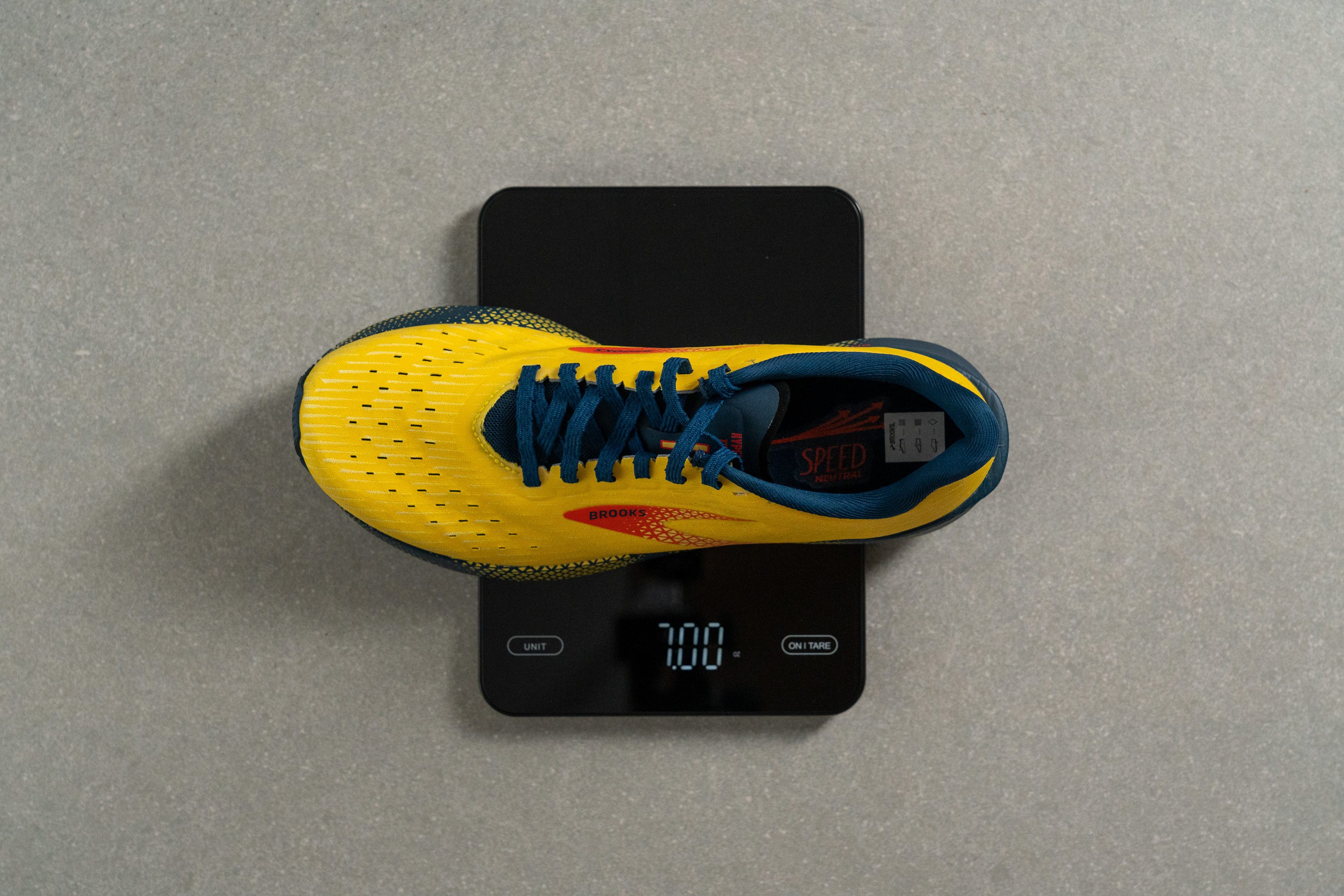
| Hyperion Tempo | 7.0 oz (198g) |
| Average | 9.3 oz (264g) |
Breathability
The Brooks Hyperion Tempo is one of the shoes with the most obvious ventilation holes we've seen in our lab.
We were eager to see if these holes worked as expected, so we put the smoke-pumping machine in the upper and started the test. We were pleased with how well the shoe breathes, though it's still slightly behind the best in the market, earning it a 4 out of 5 rating.
Brooks uses a rather dense engineered mesh, making those holes crucial. Under the light, when we moved the cut-in-half upper, the ventilation points were clearly visible.
However, don't expect high airflow in the midfoot area—though for a tempo-focused model, this is less important than in a long-run shoe.
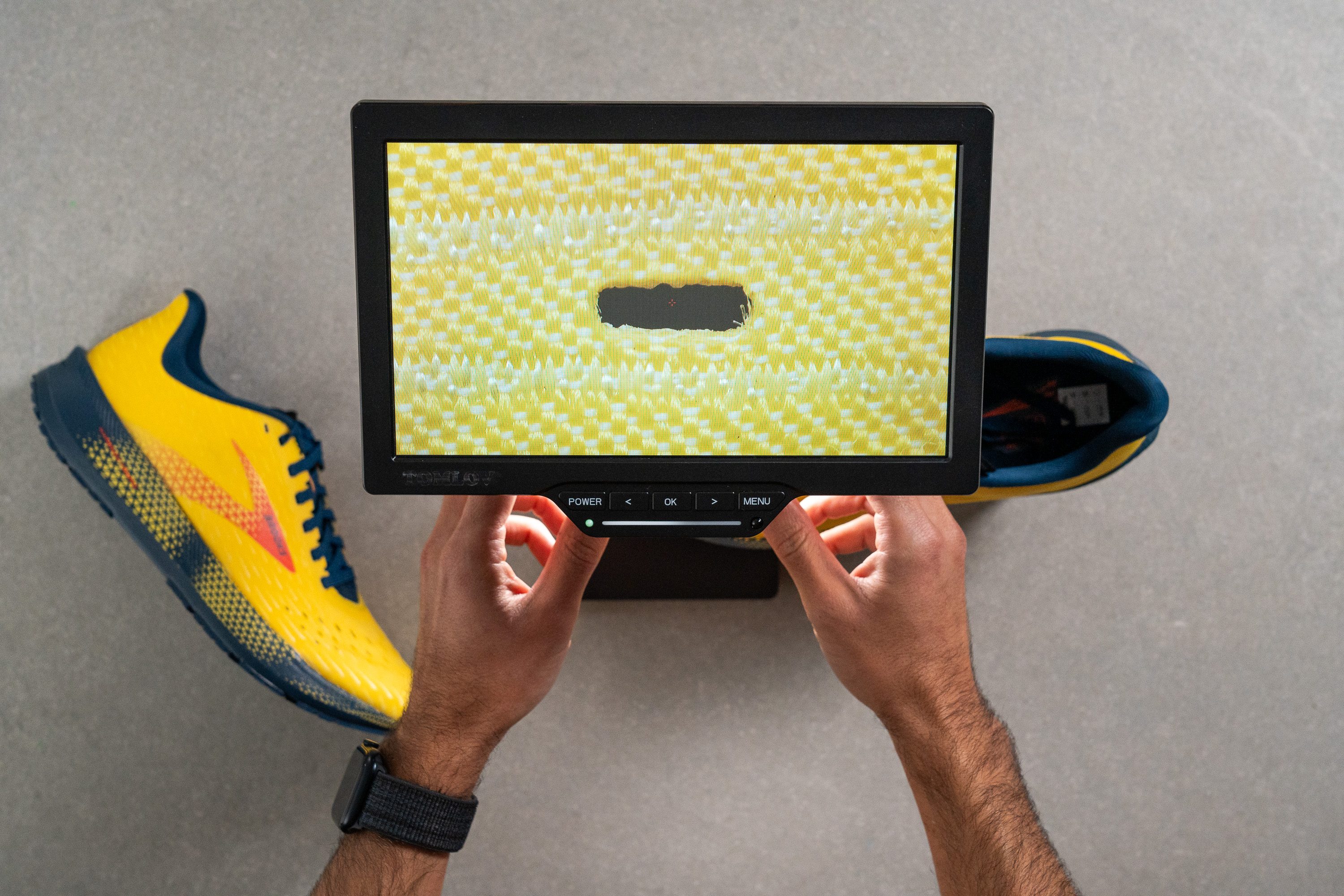
Next, we examined the shoe under a microscope to get a closer look at the holes.

The mesh seems thick and durable, which can reduce airflow, so Brooks simply laser-cut some holes in the upper—a straightforward and effective way to improve breathability.
However, this design has a downside—debris and small rocks can get into the toebox since there's no protective layer under the holes.
| Hyperion Tempo | 4 |
| Average | 3.7 |
Stability
Lateral stability test
The DNA Flash midsole is not only lightweight and responsive but also excels in keeping your foot stable as you run. This stability is a direct feature of being too soft.
Additionally, its low stack height brings you closer to the ground, offering much more stability than you'd find in maximalist shoes.
Torsional rigidity
Another advantage of minimising the stack height is that Brooks doesn't have to create a rigid shoe to achieve a decent level of stability, nor do they need to insert a plate.
As a result, they've crafted a flexible shoe—rated 2/5 by our team in the lab—that effortlessly twists and bends. This feature is particularly impressive during track workouts, as it actively engages your feet, creating a "wow!" feeling due to its flexibility and natural ride.
| Hyperion Tempo | 2 |
| Average | 3.5 |
Heel counter stiffness
The heel counter seemed quite average to us, offering a safe heel lock without being too intrusive. We rated it a 3 out of 5, which aligns with most neutral shoes.
| Hyperion Tempo | 3 |
| Average | 2.9 |
Midsole width - forefoot
When we first visually inspected the midsole dimensions of the shoe, it appeared slightly narrower than the average. Despite our first impression, the forefoot is quite average at 112.5 mm, which adds to the overall stability of the shoe.
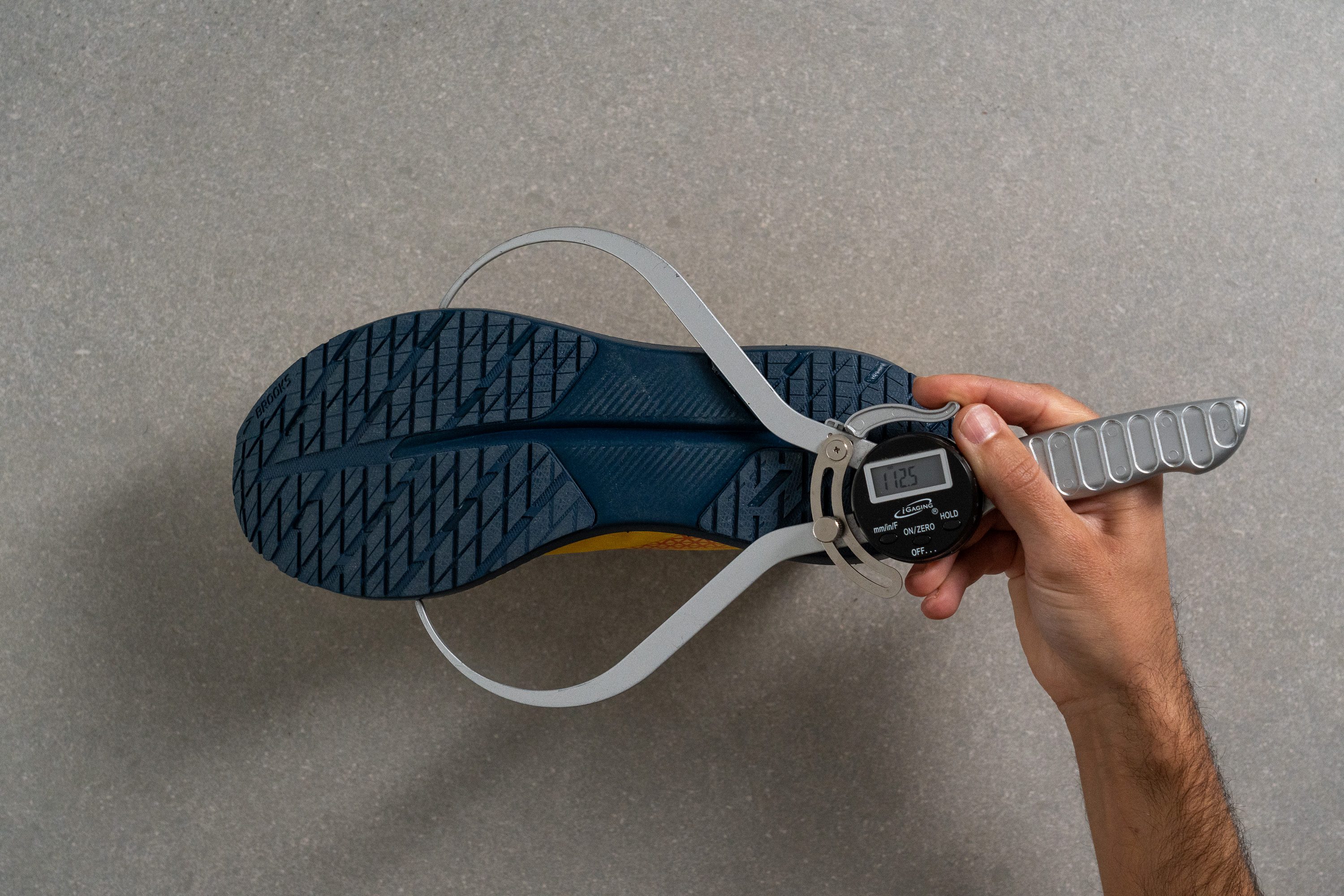
| Hyperion Tempo | 112.5 mm |
| Average | 114.4 mm |
Midsole width - heel
However, the heel measurement aligned more with our initial observation, measuring 83.7 mm with our callipers. This is quite narrow, similar to a competition shoe.
In fact, based on its stack height and geometry, this shoe could be an excellent choice for 5K/10K races. However, in our opinion, it falls short of being a top contender in that category due to its midsole, which doesn't match the quality of top-tier racing foams like ZoomX or Lightstrike Pro.
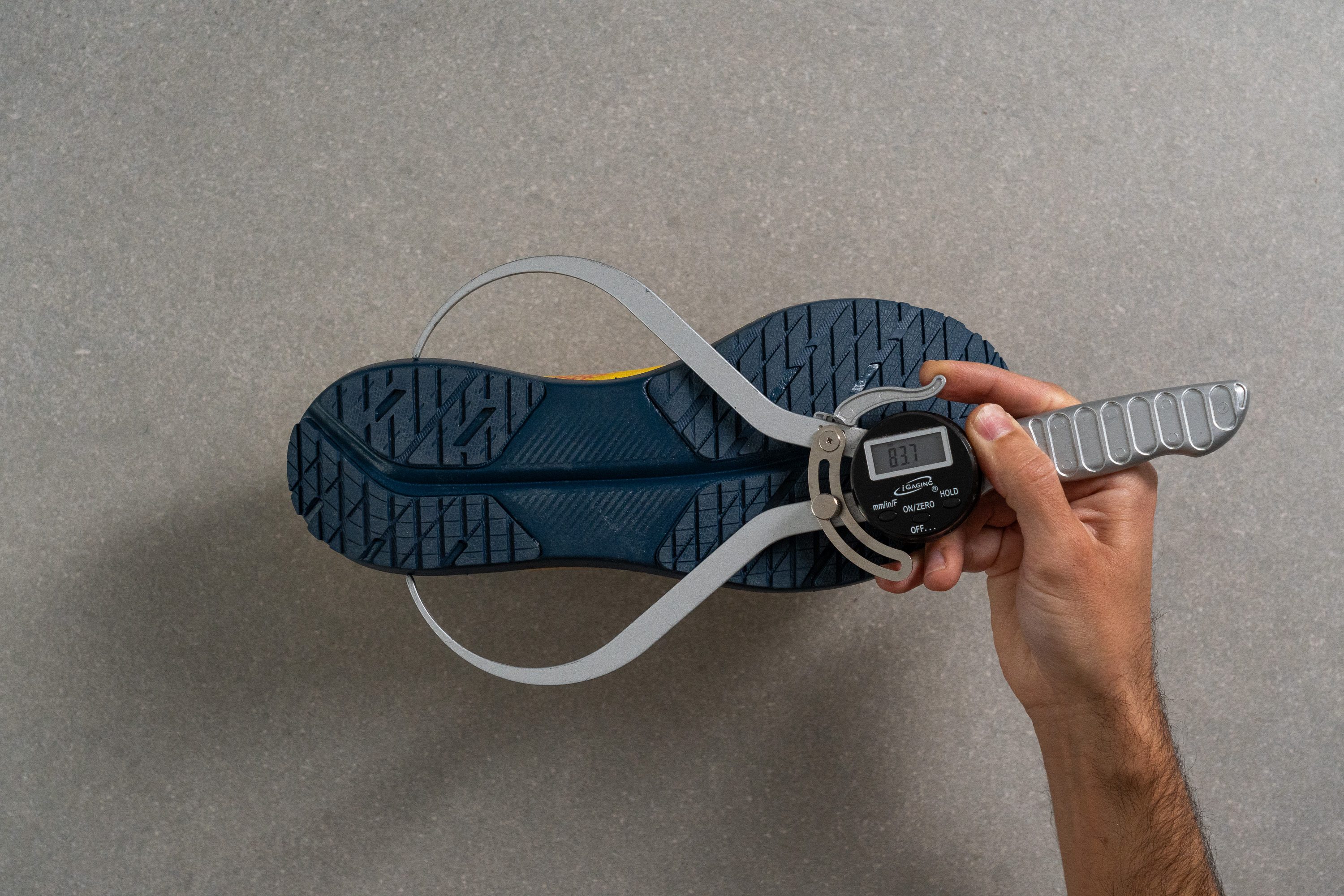
| Hyperion Tempo | 83.7 mm |
| Average | 90.7 mm |
Durability
Toebox durability
One of the key benefits of using a tough mesh is its outstanding durability. Yet, we were concerned that the laser-cut ventilation holes might compromise this feature.
However, our Dremel test pleasantly surprised us! The Tempo performed admirably, securing another impressive 4 out of 5 rating. This impressive achievement in such a challenging test was made possible because Brooks smartly maintained sufficient space between the holes.
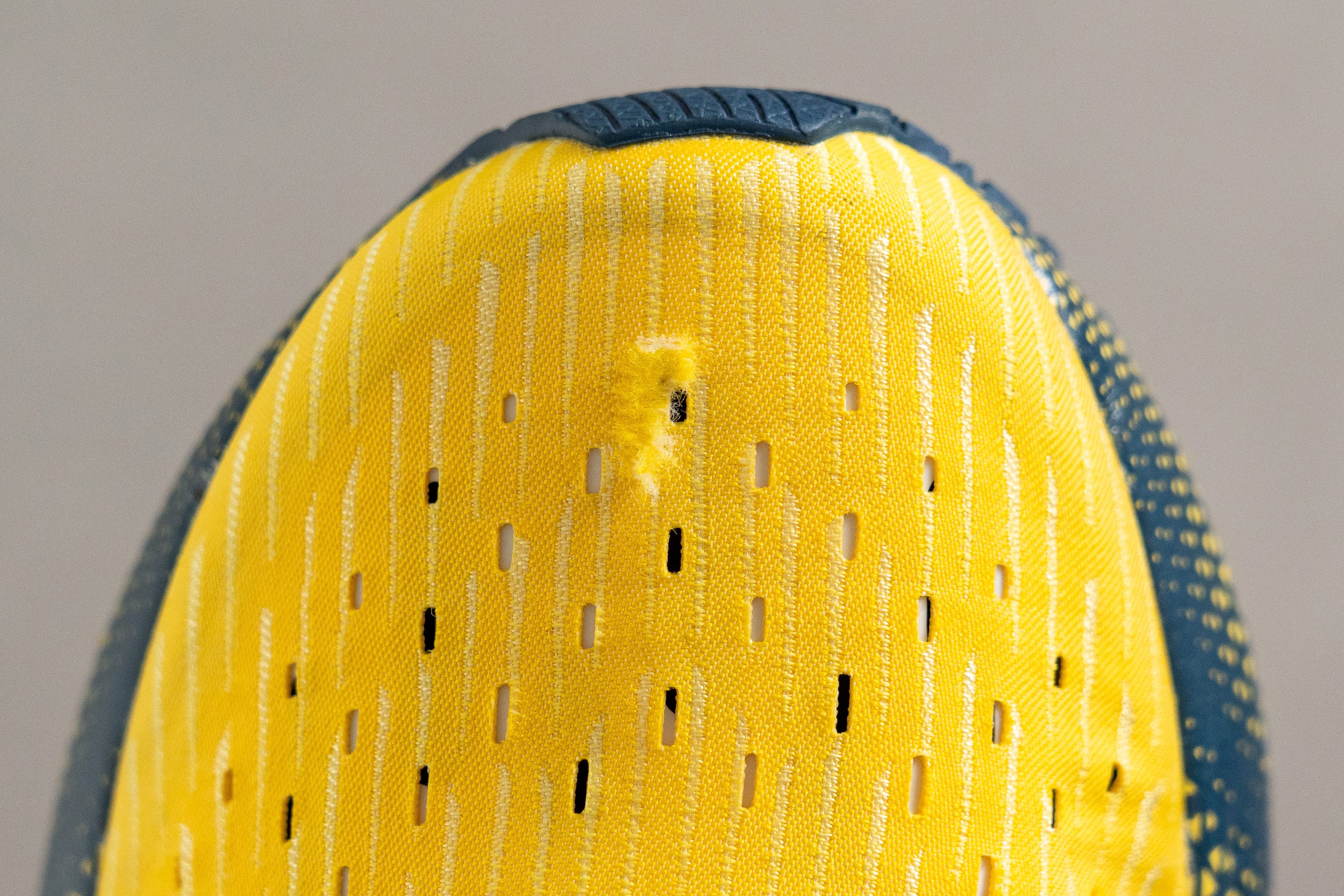
| Hyperion Tempo | 4 |
| Average | 2.6 |
Heel padding durability
Following the successful Dremel test on the toe area, we shifted our focus to the heel to see if the good results would persist.
Sadly, they didn't. The heel sustained considerable damage after undergoing the same test at 5K RPM (3.2N), leading us to give it a disappointing 2 out of 5 rating.
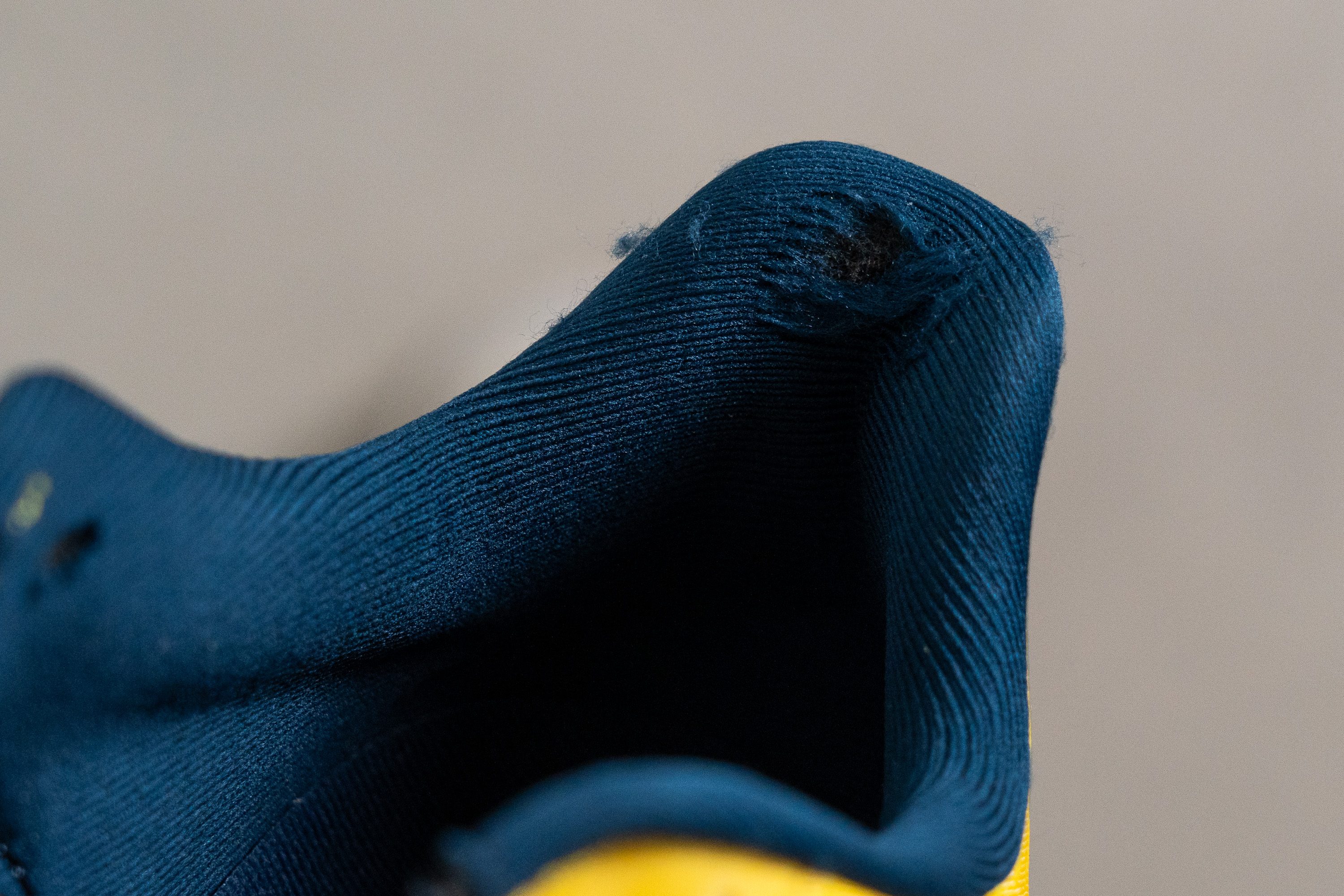
| Hyperion Tempo | 2 |
| Average | 3.4 |
Outsole hardness
We then turned our attention to the shoe's outsole. This design makes it more suitable for dry, flat surfaces like asphalt, concrete, or a track.

With this in mind, we used a durometer set to the Shore C scale and recorded a result of 85.1 HC. This is slightly harder than average, so we're curious to see how this will affect the shoe's durability.
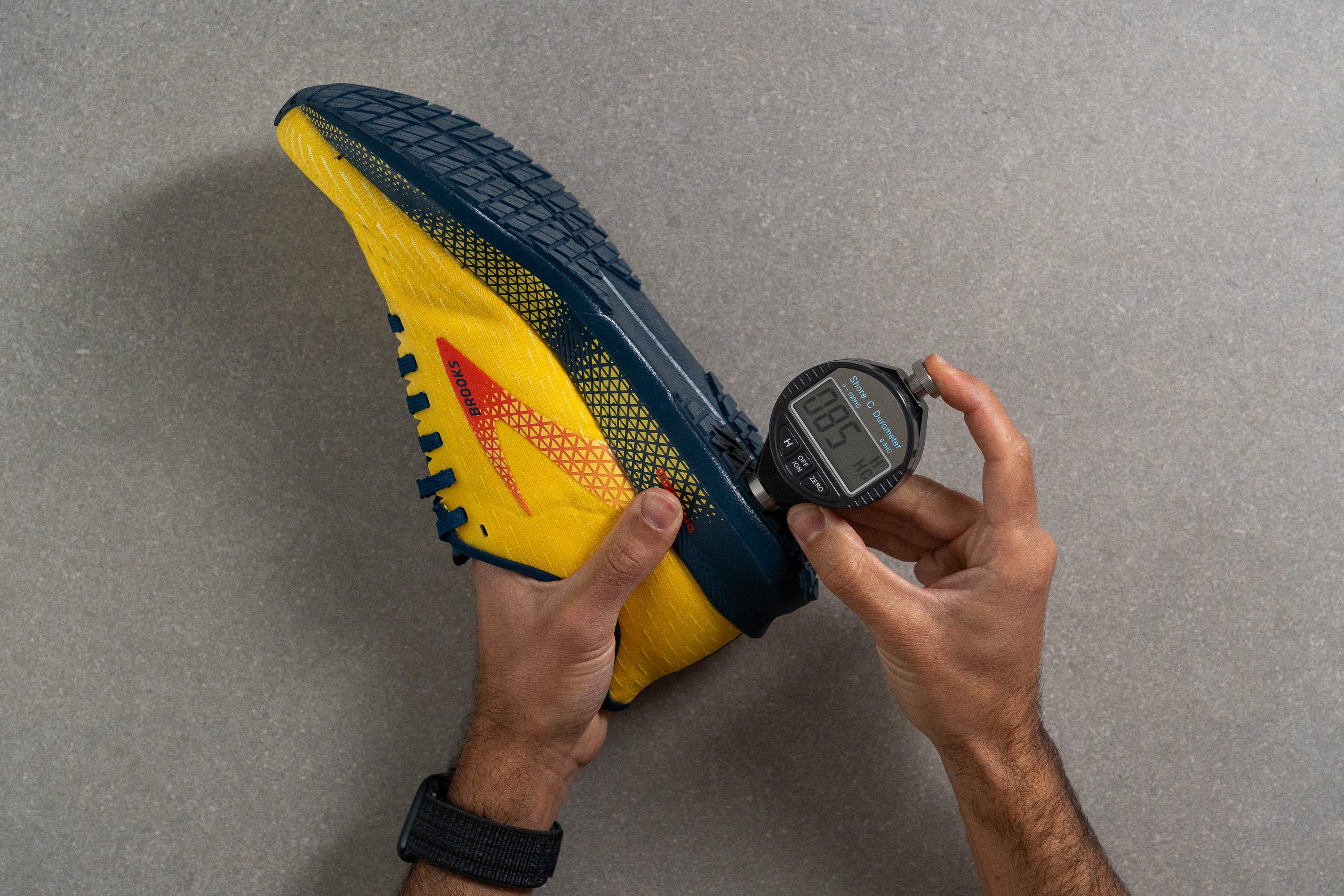
| Hyperion Tempo | 85.1 HC |
| Average | 79.2 HC |
Outsole durability
To test whether the outsole's high hardness really works, we used the Dremel again, this time at 10K RPM and the same 3.2N force.
Post-test, we noted an impressively tiny 0.2 mm indentation, which confirms the outsole's excellent durability. The Hyperion Tempo is really built to last and has good rubber coverage.
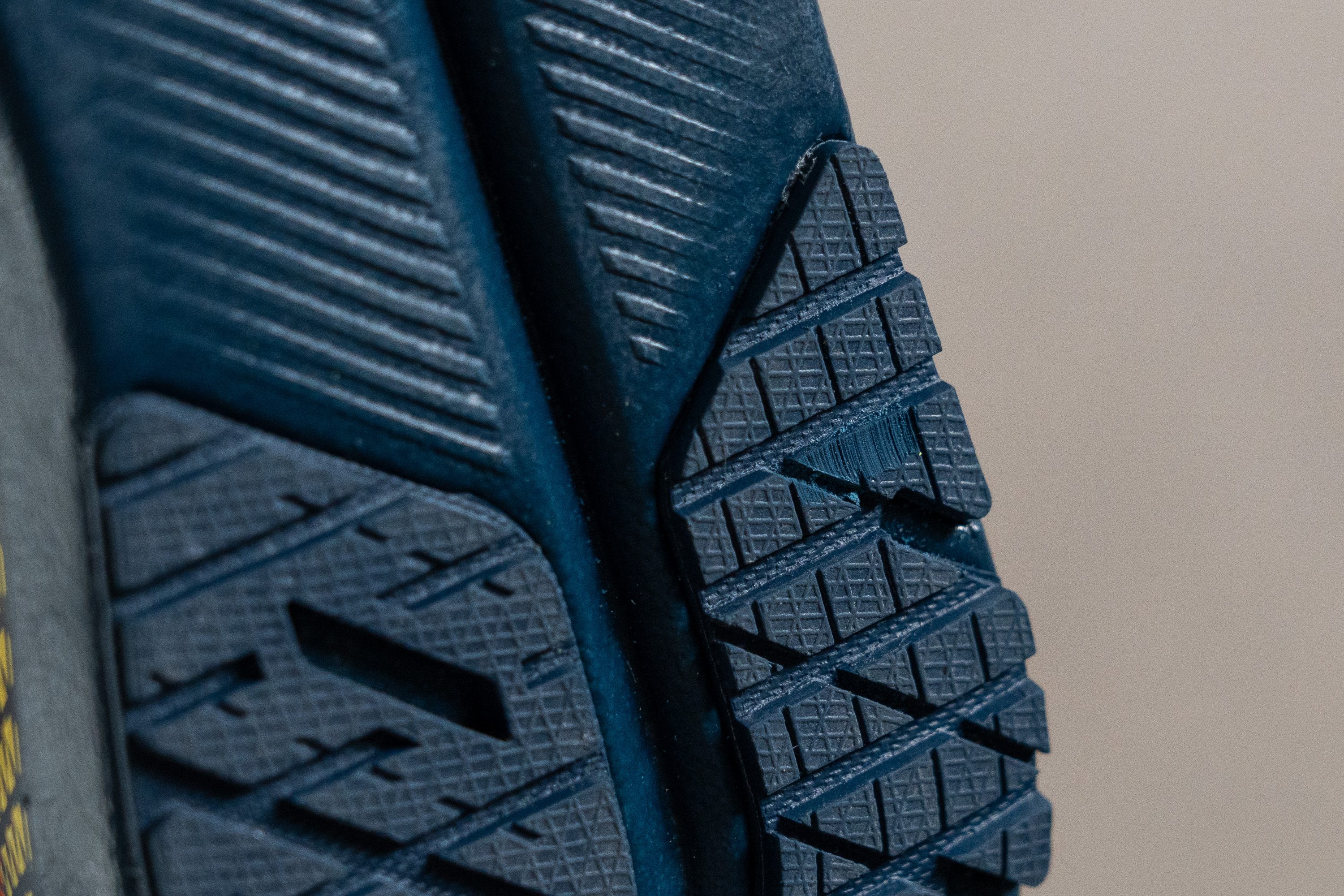
| Hyperion Tempo | 0.2 mm |
| Average | 1.1 mm |
Outsole thickness
With a substantial 3.3 mm outsole thickness, we see more evidence of this outsole's longevity.

In fact, we believe Brooks could shave off nearly a millimetre of foam to reduce some extra weight from this already featherlight shoe.

| Hyperion Tempo | 3.3 mm |
| Average | 3.2 mm |
Misc
Insole thickness
At just 2.8 mm, the insole is nearly half as thin as that of an average shoe. This is just another method of reducing weight, though it comes at the cost of some comfort.
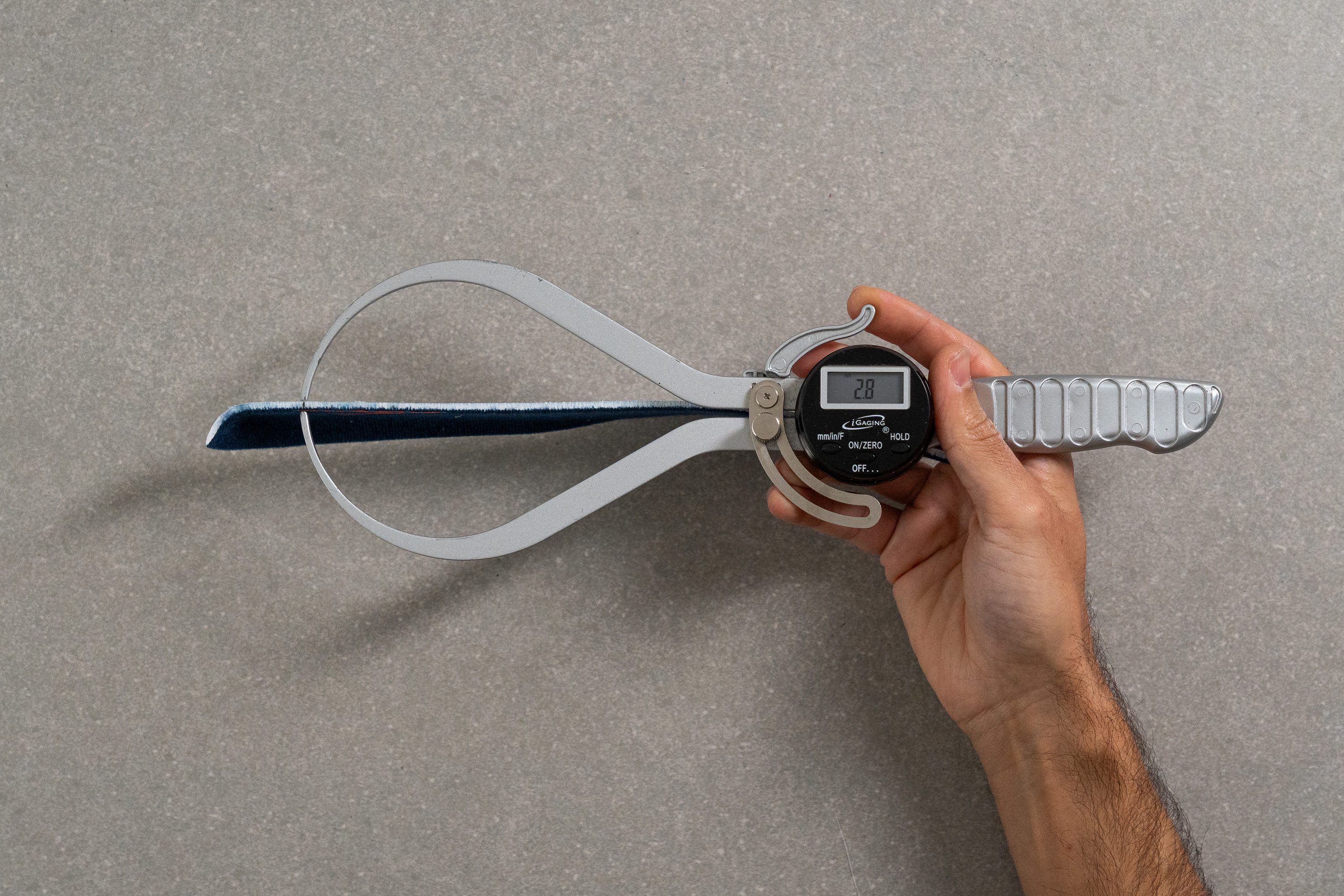
| Hyperion Tempo | 2.8 mm |
| Average | 4.5 mm |
Removable insole
The insole is removable, and there's enough of space inside, so we easily swapped it with insoles from other shoes without any problems.
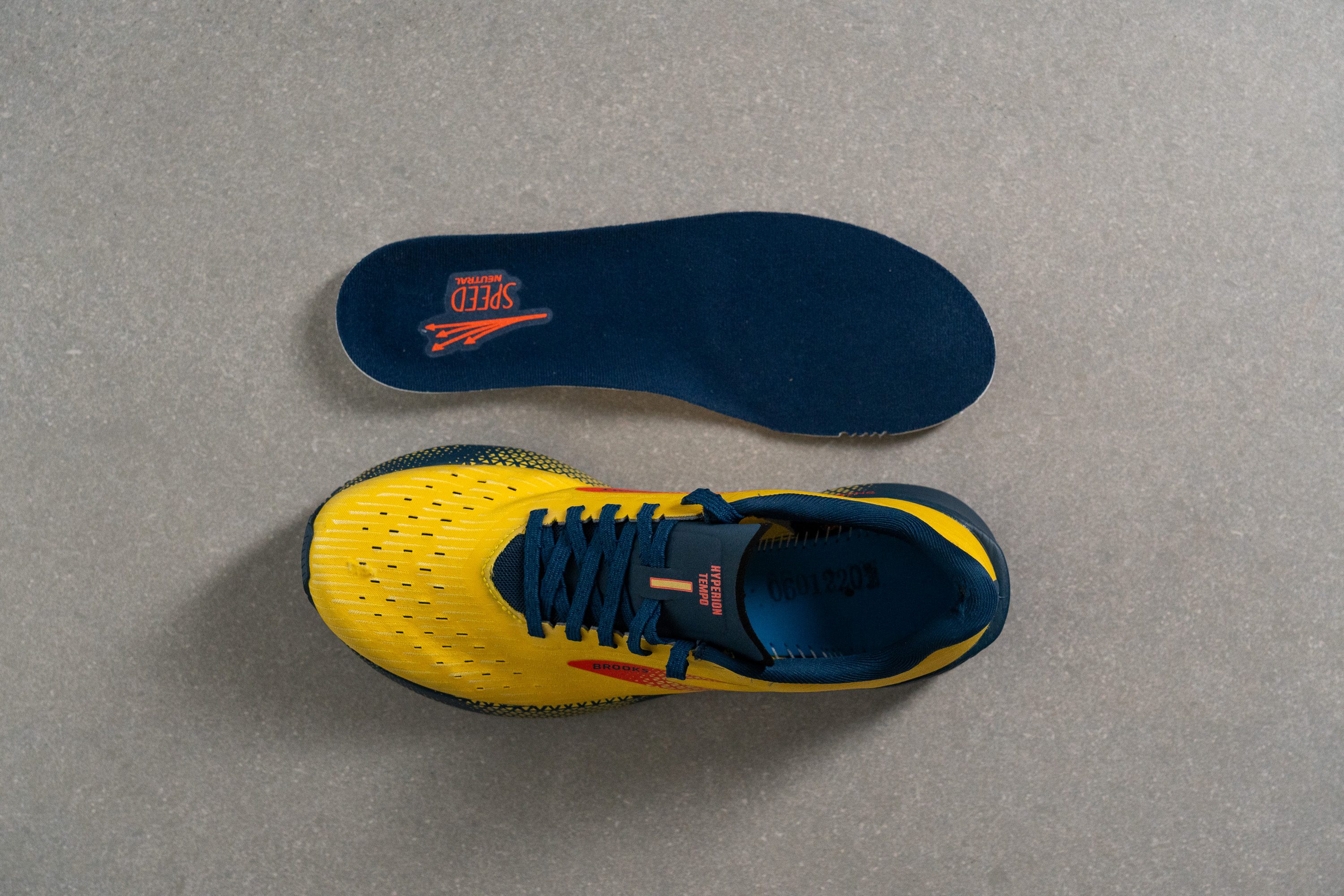
| Hyperion Tempo | Yes |
Midsole softness in cold
After placing the shoe in the freezer for a 20-minute cool-down, we retested it to see the results. The new measurement on our durometer is 26.5 HA.
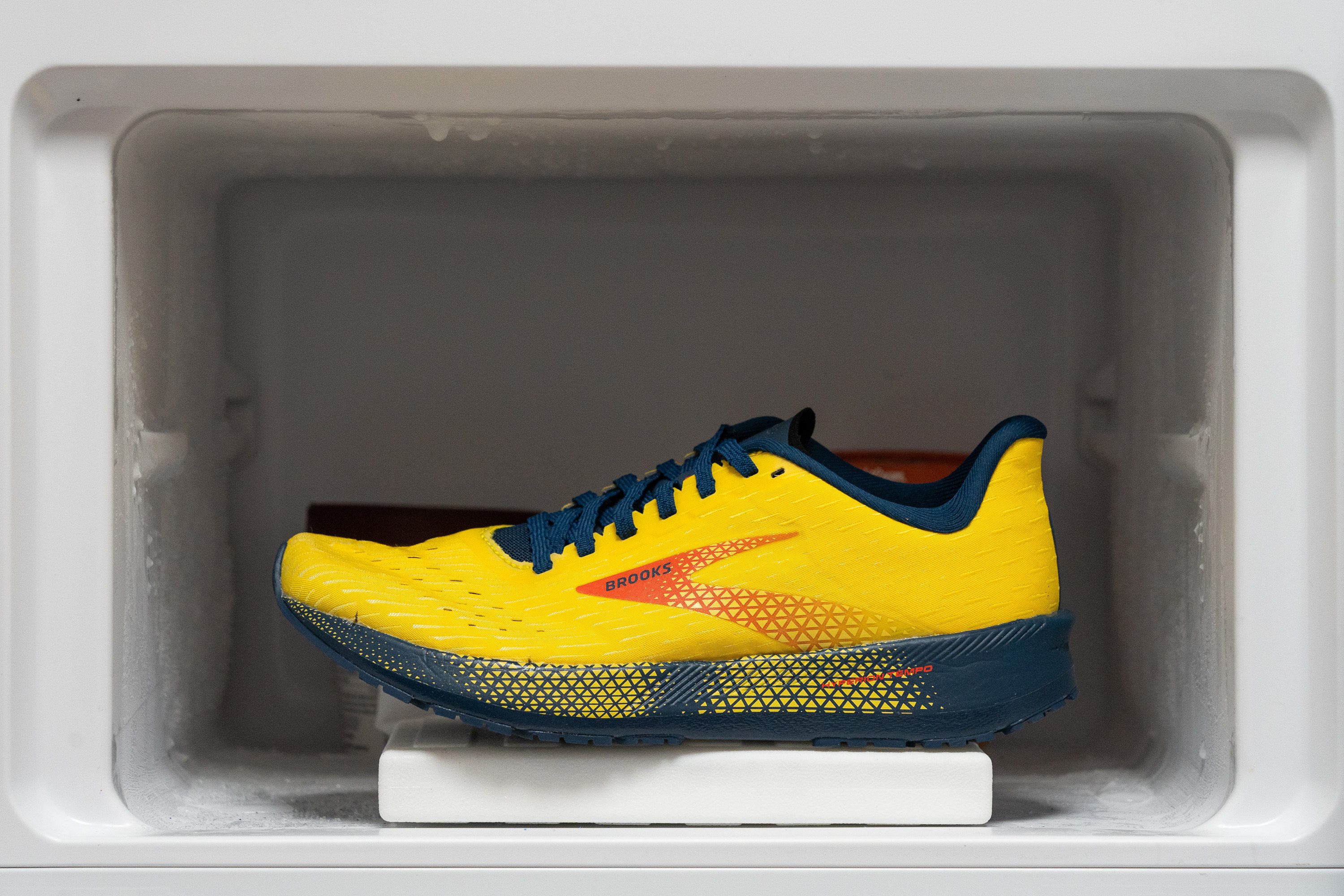
| Hyperion Tempo | 26.5 HA |
| Average | 25.1 HA |
Midsole softness in cold (%)
That's just an 18.8% increase, an outstanding result for an EVA-based foam, which typically underperforms in this test.
This confirms that even in winter, the midsole will provide a consistent feel and maintain its high-level performance.
| Hyperion Tempo | 19% |
| Average | 24% |
Reflective elements
The Hyperion Tempo completely lacks reflective elements, an omission that's quite noticeable in a £150 shoe, especially for those who run in low-light conditions.

| Hyperion Tempo | No |
Tongue padding
As a tempo training shoe with a major focus on minimising weight, we were pleasantly surprised to find a 5.8-mm thick tongue.
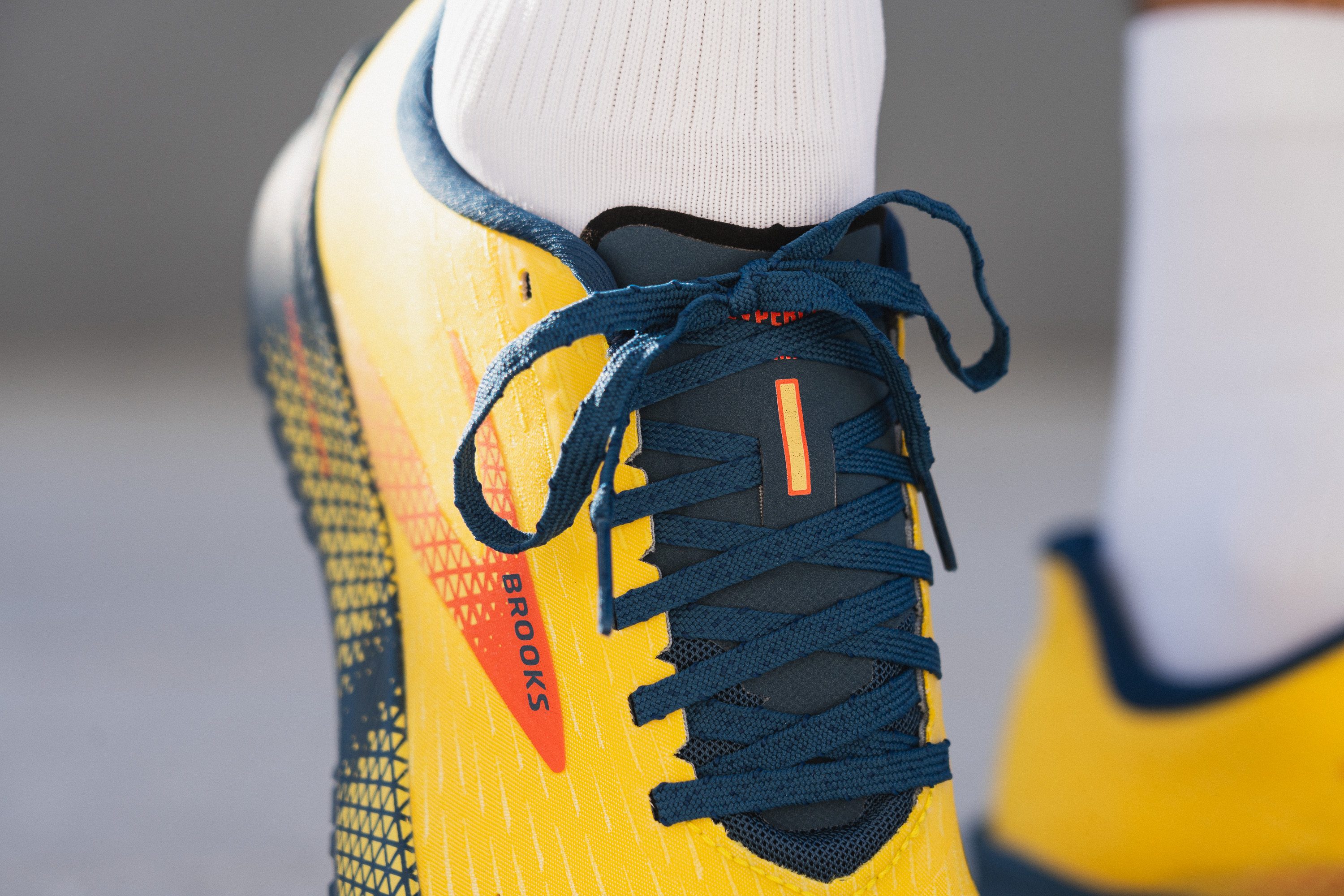
This ensures comfort and a secure lockdown.
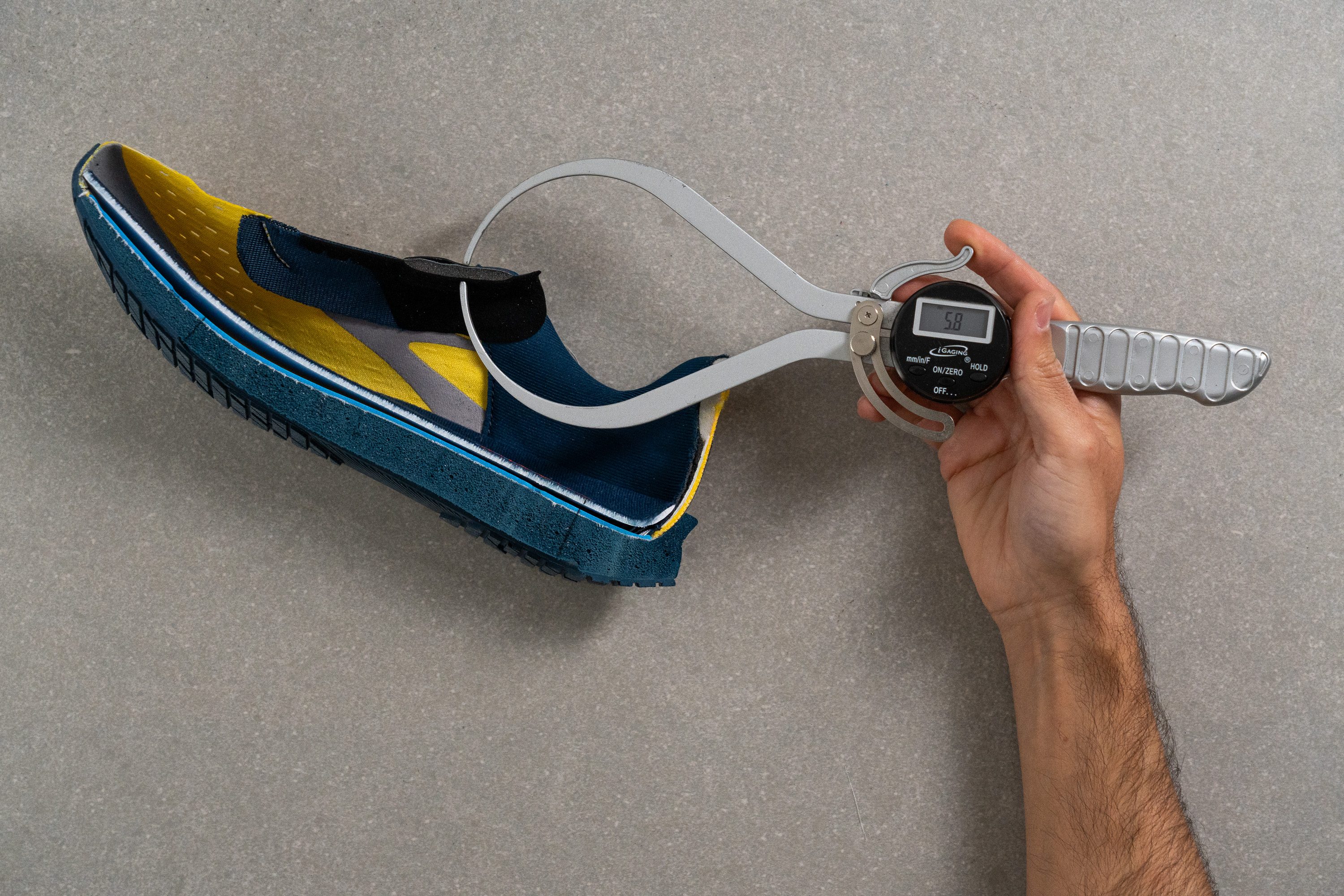
| Hyperion Tempo | 5.8 mm |
| Average | 5.8 mm |
Tongue: gusset type
For a price of £150, we expect a gusseted tongue to prevent it from shifting side-to-side during high-speed workouts, which is the shoe's intended purpose.
This feature should definitely be included in the next version.

| Hyperion Tempo | None |
Heel tab
The Hyperion Tempo lacks a heel tab, but it was absolutely not necessary for slipping our feet into the shoe. Moreover, its absence contributes to the shoe's impressive weight savings...

| Hyperion Tempo | None |

